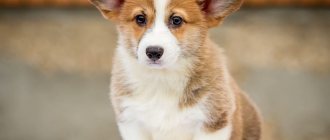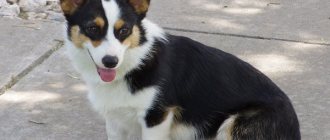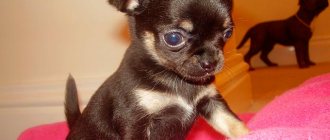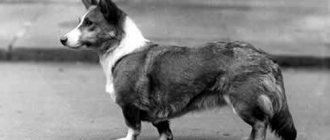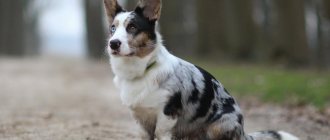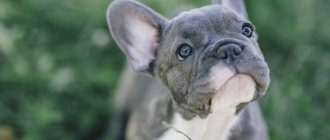| Breed name: | Welsh Corgi Pembroke |
| Breed name in English: | Welsh corgi rembroke |
| Country of origin: | UK (Wales) |
| Type: | A small dog |
| Weight: | 9-12 kilograms |
| Height (height at withers): | 25-30 centimeters |
| Color | White, red, sable |
| Wool length | Short |
| Lifespan: | 12-15 years |
| Character | Smart, loyal, active |
| Number of puppies (average): | 3-8 |
| Price of puppies: | From 1000$ |
Description
The Pembroke Welsh Corgi is a small dog of short stature and strong build. The animal is a wonderful companion. It is very sweet, smart, active and loyal. This breed and the Cardigan Welsh Corgi are often confused, despite their clear differences. Pembrokes have a slightly smaller body, pointed ears and short tails. But the cardigan, on the contrary, has a long tail.
Reduced life expectancy due to inbreeding
Inbreeding can significantly reduce the lifespan of a Welsh Corgi. This is the name given to the crossing of closely related individuals. This method is used by unscrupulous breeders. The main task for them is to obtain maximum profit from the sale of puppies, for which they use unacceptable matings. The danger of inbreeding is that children inherit all the defects of their parents. Moreover, in this case, the positive qualities inherent in this branch may become negative.
Dog lovers who want to adopt a Corgi should be extremely careful when choosing a breeder. You can only purchase a puppy from reliable, trusted dog breeders. To do this, you need to visit websites, forums, read reviews, chat with people who have already purchased a corgi from this breeder.
Appearance
— Advertising —
The dog has a strong build, smooth fur and an intelligent facial expression.
An adult Pembroke Welsh Corgi weighs about 9-12 kilograms and is 25-30 centimeters tall.
The head of the individuals is similar to that of a fox. The skull is wide and has a small “cavity” at eye level. The muzzle is conical, the nose is black. The eyes are well set and brown in color. Corgi ears stand straight up. They are long, rounded at the end, and medium in size.
— Advertising —
The neck is quite elongated. The pet's front legs are short and straight, slightly curved. Body of medium length. The hind legs are slightly rounded and powerful.
This breed may or may not have tails. They come in these forms:
- Spiral twisted like a corkscrew.
- Throwed over the back, like a fox.
- In the form of a lowered saber.
Many owners prefer to have their ponytails docked.
The dog's coat is dense and of medium length. There are several possible colors: various shades of red with white spots on the feet, neck and chest; sable coloring (black hairs alternate with red); a color called tricolor (for example, black and red with white spots).
Pros and cons of a dog
Characteristics of advantages:
- This is a playful, active, athletic dog that will always enjoy exercise.
- Loving and faithful.
- Has short coat, easy to care for.
- The dog is polite with strangers, but at the same time is a good watchman.
- The pet gets along well with other pets.
- This is a relatively healthy breed that rarely suffers from hereditary diseases.
Characteristics of minuses:
- In the absence of mental and physical stress, pets will chew and destroy objects in the house.
- The dog has territorial aggression towards animals he does not know.
- The dog sheds heavily in the fall and spring.
- One of the bad habits of some individuals is to constantly bark.
- Animals love to chase everything that moves.
- This is an expensive breed, especially if the puppies are elite.
About physical activity for Welsh Corgis:
Some may be misled by the compact dimensions of this dog. But since the dog is a representative of shepherds, active physical activity is extremely necessary for them. Then the corgi will not only not suffer from various kinds of diseases, but will also be able to boast of an easy-going character and a healthy psyche.
Long walks are for them. The optimal regime for walking is 2-3 hour sessions per day. It is important to give your dog the opportunity to run around in large wooded areas or fields to reminisce about his herding past and awaken his instincts.
Train Pembrokes and Cardigans to trot at different paces. This method strengthens ligaments and intensively develops muscles.
Corgis will also be happy to keep you company in any active activity, for example, you can take them for a run or a bike ride, on a hike or on a car trip. Also, animals will not refuse to swim - water “fitness” will strengthen their muscles and vestibular apparatus.
History of the breed
There is a legend that Pembroke Corgis were the horses of Welsh fairies. This is evidenced by the coloring on their back in the shape of a saddle.
The Pembroke Welsh Corgi was first mentioned in records in 920 AD. They are believed to have been brought to Wales by Flemish weavers. From the 14th to the 18th centuries they were used only for grazing livestock. Thanks to their small stature and agility, the dogs bit cattle on the legs and then managed to dodge the blows.
As the name suggests, the Pembroke Welsh Corgi was bred in Wales in the Pembrokeshire region. The Cardigan Welsh Corgi is the older of the two Corgi breeds. Therefore, of course, it was used in breeding the Pembroke species.
The breed was recognized by the English Kennel Club in 1928. Back then, Pembroke and cardigan were considered the same species. Only in 1934 a standard for each type was identified.
The Pembroke's appeal increased when it became a favorite of King George VI and subsequently Queen Elizabeth II. By the 1960s, the Corgi had become one of the most popular pet breeds throughout the world, especially in Britain.
Maintenance and care
The Pembroke Welsh Corgi has a medium length coat with a short undercoat. The breed has a tendency to lose a significant amount of it. This occurs especially intensively in spring and autumn. Regular grooming of your dog is very important. It mainly consists of brushing the coat once or twice a week. During molting, carry out the procedure daily. Brushing should ideally take 10 minutes to completely remove dead hair.
The frequency of bathing will vary depending on what activities your dog participates in. It is recommended to bathe your dog every 6-8 weeks. For the procedure, use warm water and special shampoo.
Groom and trim your pet's nails regularly to prevent furniture scratching. It is recommended to carry out the procedure every 2-3 weeks.
Keep your pet's teeth and gums healthy. To do this, clean them daily or at least a couple of times a week.
This is an active breed that loves to run. Therefore, it is important to give your pet daily exercise to prevent obesity. Too much wasted energy and lack of training can lead to excessive barking and other behavior problems.
How to extend the life of a pet?
First of all, measures to prolong the life of the Welsh Corgi should be aimed at preventing obesity and related comorbidities . To do this, it is necessary to provide the pet with adequate physical activity.
To ensure that your pet receives the physical activity it needs, your Welsh Corgi can engage in sports, such as freestyle or agility, while it is still young.
Nutrition
Feed adult dogs a high-quality food. Follow these guidelines, but take into account the general activity of the animal:
- Weighing 9 kg or more – from 129 to 176 g.
- Weighing 10 kg or more – from 139 to 189 g.
- Weighing 11 kg or more – from 149 to 196 g.
- Weighing 12 kg or more – from 159 to 209 g.
Feed twice a day: the first time in the morning and the second in the evening. Do not overfeed your pet, no matter how much he asks. Excessive amounts of food lead to obesity and shortened lifespan of individuals.
Older Corgis should be fed food that suits their needs at this stage of life. It is important to choose the right food. Below is the approximate amount of necessary substances for an elderly dog:
- Protein from 14 to 21%.
- Fats less than 10%.
- Fiber less than 4%.
- Calcium 0.5-0.8%.
- Phosphorus 0.4-0.7%.
- Sodium 0.2-0.4%.
Breeding
Before mating, the health of the individuals is checked. This is especially true for genetic diseases. It is not permissible to breed long-haired, nervous and biting dogs.
Dogs are bred when males are 24 months old and females are 20 months old. Although the first heat in girls occurs at 7-8 months. Females over the age of nine years are not allowed to become pregnant.
The girl is prepared for mating in advance: vaccinations are given, prophylaxis against parasites, the condition of the heart, joints, and thyroid gland is checked.
Before the procedure, the individuals are introduced: they are walked together or left in a room for communication.
The bitch's pregnancy lasts from 2 to 2.5 months. As a result, from 3 to 8 puppies are born. Be sure to ensure that a specialist is present at the birth. Your pet may need a caesarean section.
Puppies
Within the first few days after purchase, take your new friend to the veterinarian. This is necessary to ensure the health of the animal. Visit a specialist periodically for vaccinations, deworming and annual tests.
Pembroke Welsh Corgis need daily exercise to stay in shape. The baby will need more of them than adults. Spend at least 15 minutes a day exercising. Training and education should be carried out by you from a very early age.
Many owners wonder: what is the best way to feed small corgis? Feed your babies special high-quality food. The approximate amount of food depends on body size and age. The scheme is as follows:
- 2 months – from 153 to 161 g.
- 3 months – from 179 to 193 g.
- 4 months – from 191 to 209 g.
- 5 months – from 194 to 213 g.
- 6 months – from 194 to 213 g.
- 8 months – from 157 to 191 g.
- 10 months – from 139 to 147 g.
After your baby reaches 1 year of age, feed him as an adult.
Stick to the following schedule:
- For puppies between 8 and 12 weeks of age, feed food 4 times a day.
- From 3 to 6 months – three times a day.
- From 6 months to 1 year – 2 times a day. Then you can leave eating 2 times a day, or you can reduce it to once.
Photos of the babies are presented below.
Age compared to human years (table)
| Welsh Corgi age | Person's age |
| 1 year | 15 years |
| 2 years | 24 years |
| 3 years | 28 years |
| 4 years | 32 years |
| 5 years | 36 years |
| 6 years | 42 years |
| 7 years | 47 years old |
| 8 years | 51 years old |
| 9 years | 56 years old |
| 10 years | 60 years |
| 11 years | 65 years old |
| 12 years | 69 years old |
| 13 years | 74 years old |
| 14 years | 78 years old |
| 15 years | 83 years old |
| 16 years | 87 years old |
Dog character
The pet loves to be close to people. This breed is known to want constant interaction with the entire family. They may suffer from separation anxiety when left alone for long periods of time.
As a companion, the Corgi is protective of its family and will warn of any strangers. Animals need to be socialized at an early age to know how to behave around people they don't know.
Dogs are suitable for children and the elderly. When Corgis become agitated, they may bite their heels in response to play. This is due to their original job of being shepherds.
Pets are known to bark a lot if they are not trained. However, they are easy to train due to their high intelligence. The dog loves to be constantly busy. During training and training, use gentle methods, as the dog does not tolerate roughness.
The dogs get along well with other dogs and pets.
Some Pembrokes love to swim, especially in hot weather. However, if your pet doesn't want to go into the water, never force him. This can frighten the dog and cause him stress.
Advantages
- Corgis are truly suitable for beginner dog owners. They are quite easy to train and do not require special care (with the exception of the Fluffy subspecies). Representatives of this breed settle well into the family, quickly become attached to all its members and do not enter into conflicts with other animals or children.
- These dogs are considered very smart . They easily remember commands, learn and adapt. Corgi understands the mood of the owner from the moment a strong bond is formed between them. This pet can truly fully replace a friend and companion.
- Representatives of the species, in principle, do not conflict. They show their friendliness towards other animals and familiar people. They are wary of strangers, but in most cases this rule does not apply to children. Corgis are loyal, kind and gentle dogs, making them suitable for most people.
- The breed standard states that these dogs have a real sense of humor. They are able to amuse their owners and the people around them.
Education
Pembroke Welsh Corgis are intelligent animals, so training them is not that difficult. Here are some tips you can follow when training:
- Be persistent when training your dog. Like other breeds, Corgis instinctively seek out an "alpha male" or "pack leader." Therefore, you need to show your authority so that the puppy always obeys you.
- Use incentives. Never use harsh methods or force. This attitude will make your puppy fear you rather than respect you. Instead of yelling or intimidating your dog, give him treats for doing the right thing. However, don't overdo it with rewards. Overfeeding individuals leads to obesity.
- Socialize your puppy from an early age. Don't be afraid to introduce him to new situations, people and other animals.
- Be consistent. For example, don't reward your dog both times he gets a trick right and only gets it halfway the second time. This will send mixed signals to your pet. He will not understand what actions are correct.
- The first commands your pet should know are: come, sit, stay, be quiet, no, leave it, place.
Main causes of premature death
The Welsh Corgi has a predisposition to some serious diseases and pathologies, which can ultimately lead to the death of the animal or to a critical deterioration in the quality of its life, which is why the owner of such a dog may seriously face the question of euthanizing the pet for humane purposes.
Such ailments include the following:
- Degenerative myelopathy, often causing paralysis of the hind legs.
- A bleeding disorder, also called von Willebrand syndrome.
- Epilepsy.
- Urolithiasis disease.
- Kidney pathologies.
- Congenital heart defect (patent ductus arteriosus).
CAREFULLY!
Welsh Corgi bitches often experience pathological births, which is associated both with the large size of the puppies (by the time of birth, babies often weigh 500 grams) and with structural features (narrow and long birth canal).
Therefore, in order to minimize the risk of losing your pet, it is necessary to promptly seek veterinary help during childbirth.
But not only diseases cause the premature death of Welsh Corgis.
The owner's inattention or unwillingness to raise and train the pet also often leads to tragic consequences .
Poisoning due to unattended rodent baits, a dog swallowing inedible objects, death under the wheels of a car, a pet falling out of a window - these and many other accidents can be prevented if you treat your dog responsibly.
The Welsh Corgi, like any other dog, needs proper training and commands . In addition, you must remember that you can let your pet off the leash either in a fenced area or away from the highways.
At home, you need to carefully monitor the dog, especially if it is a small puppy who can grab inedible and even dangerous things.
You should immediately remove all chemicals, varnishes, paints, as well as needles, pins and other sharp objects immediately after using them.
The same goes for clothes, shoes and other inedible things that a pet can swallow whole or chew and swallow pieces of fabric or plastic.
Diseases
The Pembroke Welsh Corgi is considered a healthy dog. But there are a number of diseases and health conditions that are genetic. This does not mean that your pet will necessarily have such problems. It just needs to be noted that the species is at greater risk of contracting the disease than other breeds. Here is a description of some common genetic problems:
- Heart diseases. Pembrokes are susceptible to a condition called incomplete closure of the heart valve. In this condition, the small valve that passes blood between the two parts of the heart does not close properly. Therefore, too much blood enters the lungs, which leads to fluid accumulation and increased stress on the heart. Main signs: cough, fatigue during exercise, weight loss, shortness of breath and weakness in the hind legs. Contact a specialist immediately.
- Blood clotting disorder. The animal appears healthy until serious injury or surgery occurs. As a result, severe bleeding may occur. Von Willebrand's disease is a bleeding disorder that is common in Pembroke Corgis.
- Problems with the spine. Intervertebral disc disease is a common condition in dogs with long backs and short legs. It occurs when the jelly-like cushion between one or more vertebrae slips or ruptures. This causes the disc to press on the spinal cord. Symptoms of the disease: the dog moves poorly, refuses to climb stairs, has a hunched back, and cries. All this is caused by pain. Contact your veterinarian immediately.
- Dysplasia of the hip and elbow joints. Your pet's hips and elbows are at risk for dysplasia. This is an inherited disease that causes abnormal joint development and leads to arthritis. Stiffness in your Pembroke's elbows or hips can be a problem for him. Symptoms: lameness in the legs, the dog has difficulty standing up. The sooner you treat your pet, the better it will be for his health.
- Eye problems:
- cataract
- progressive retinal atrophy
- persistent pupillary membrane. This occurs when small pieces of tissue that should disappear soon after birth remain attached to the iris.
In addition to hereditary diseases, the animal may be susceptible to common diseases:
- Dental problems.
- Obesity.
- Parasites.
- Infections.
Interesting Facts
- Pembroke's personality was described in one article as being a cross between a sea captain and a high school teacher. He enjoys being involved and in charge at the same time.
- In 2012, Orange Country hosted its first Corgi Beach Day. At first it was an exhibition of 15 corgis and their owners. Today, it has become a series of organized events throughout the country. The world record took place in Huntington, California. Information states that more than 1,200 spectators attended the event.
- A Pembroke named Rufus belonged to the editor-in-chief of Amazon.com. At the stage of site promotion, he came to work with the owner every day, walked around the halls, attended meetings and dozed off during them. Later, Rufus became the site's unofficial mascot.
- For over 70 years, corgis have been part of the British family. Queen Elizabeth was the proud owner of more than 30 corgis. The Pembroke Welsh Corgi is her favorite breed.
- The species has a recessive gene called the fluffy gene. It can be in both a bitch and a dog. If the parents have this gene, then the litter may produce one or more puppies with long hair.
- When the dog lays his body on the ground, from behind his butt looks like two chicken wings. This funny position of the dog is called sploot.


